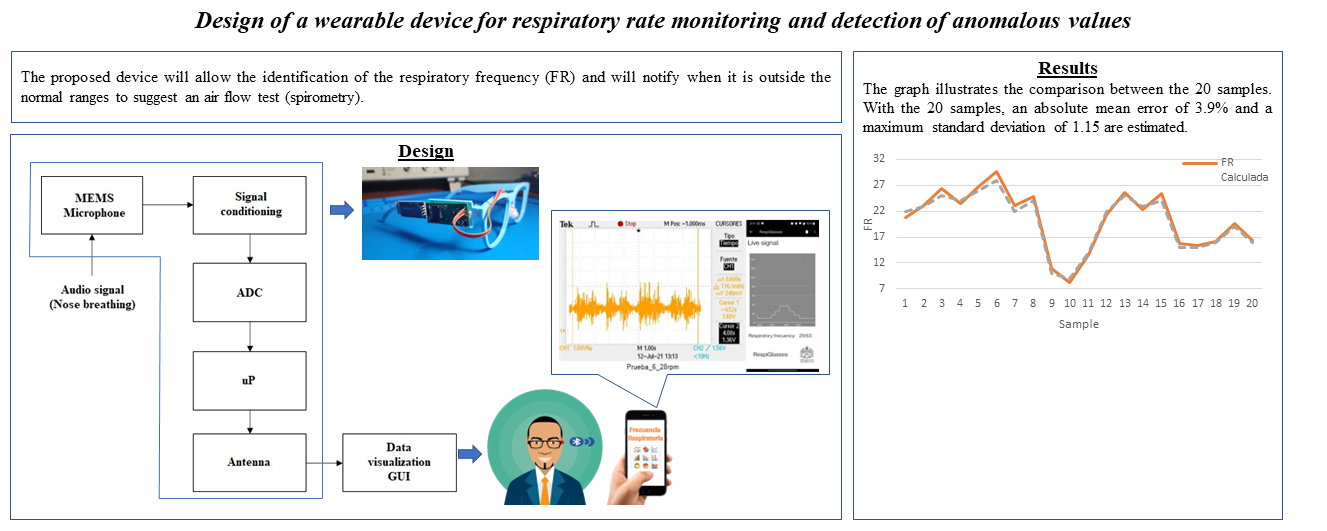Design of a wearable device for respiratory rate monitoring and detection of anomalous values
Keywords:
Biotelemetry, Design, MEMS microphone, SimulationAbstract
Abstract— Chronic obstructive pulmonary disease (COPD) is characterized by a persistent reduction in airflow. Symptoms gradually worsen and shortness of breath, dyspnea, increases over time to even appear at rest. Regarding measurement technology, spirometry is the reference standard for the diagnosis and evaluation of the severity of said condition. This test requires specialized equipment that does not allow it to be performed on an outpatient basis or for constant monitoring. For this reason, the doctor must systematically look for the presence of symptoms that may go unnoticed by the patient and that can be attributed to age, sedentary lifestyle, or the fact of smoking. Also, prolonged expiration in the trachea during a maximum forced effort can be useful in the early diagnosis of obstruction or when spirometry is not available, which is why it would be important to be able to constantly monitor breathing in order to increase the probability of identifying possible COPD at an early stage.
The solution proposed in this article is focused on the design and implementation of a wearable device that allows the monitoring of the respiratory rate. This device will allow this biometric variable to be identified and will notify when it is outside the normal ranges to suggest an airflow test (spirometry) at a possible early stage of the disease. This instrumentation system will be integrated into the frame of a pair of glasses, specifically positioning the sensor on the nasal platelets.
Downloads
References
“Enfermedad pulmonar obstructiva crónica (EPOC).” https://www.who.int/es/news-room/fact-sheets/detail/chronic-obstructive-pulmonary-disease-(copd) (accessed Sep. 01, 2020).
Q. Zhao et al., “The impact of COPD and smoking history on the severity of COVID-19: A systemic review and meta-analysis,” J Med Virol, 2020, doi: 10.1002/jmv.25889.
“EPOC | NHLBI, NIH.” https://www.nhlbi.nih.gov/health-topics/espanol/epoc (accessed Sep. 01, 2020).
“Diagnóstico y tratamiento de la EPOC - Artículos - IntraMed.” https://www.intramed.net/contenidover.asp?contenidoid=93909 (accessed Sep. 01, 2020).
C. Massaroni, A. Nicolò, D. Lo Presti, M. Sacchetti, S. Silvestri, and E. Schena, “Contact-Based Methods for Measuring Respiratory Rate,” doi: 10.3390/s19040908.
G. Singh, A. Tee, T. Trakoolwilaiwan, A. Taha, and M. Olivo, “Method of respiratory rate measurement using a unique wearable platform and an adaptive optical-based approach,” Intensive Care Med. Exp., vol. 8, no. 1, p. 15, Dec. 2020, doi: 10.1186/s40635-020-00302-6.
M. Chu et al., “Respiration rate and volume measurements using wearable strain sensors,” npj Digit. Med., vol. 2, no. 1, pp. 1–9, Dec. 2019, doi: 10.1038/s41746-019-0083-3.
“MEMS Pressure Sensors | The Design Engineer’s Guide | Avnet Abacus.” https://www.avnet.com/wps/portal/abacus/solutions/technologies/sensors/pressure-sensors/core-technologies/mems/ (accessed Sep. 02, 2020).
“Estándar de seguridad eléctrica de equipos médicos - EnergyMed: Somos el guardián de la energía para la seguridad del paciente.” https://www.energymed.com.co/estandar-de-seguridad-electrica-de-equipos-medicos/ (accessed Sep. 02, 2020).
M. de S. Nacional, “ABECÉ Mediciones en equipos biomédicos,” 2017.


